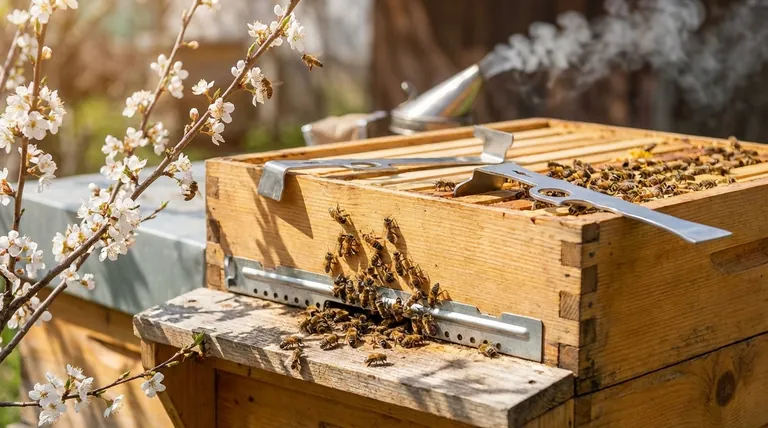A stable internal hive temperature is one of the most critical factors for honey bee colony health, directly boosting energy conservation, improving disease resistance, and accelerating population growth. By minimizing the energy bees must expend on heating or cooling, a stable climate allows the colony to allocate resources more efficiently toward raising brood and storing honey.
The central goal of managing hive temperature is to reduce stress on the colony. A thermally stable environment allows bees to shift their focus from constant climate control—a fight for survival—to the productive work of population growth and resource gathering.

The Core Challenge: Hive Thermoregulation
A honey bee colony is a superorganism that actively manages its own internal environment. Understanding this behavior reveals why external stability is so beneficial.
How Bees Regulate Temperature
Honey bees maintain a precise temperature in their brood area, typically around 95°F (35°C), which is essential for developing eggs and larvae. In winter, they form a tight winter cluster, vibrating their flight muscles to generate heat and consuming honey as fuel.
The High Cost of Fluctuation
When outside temperatures swing wildly, the colony must work constantly to counteract these changes. This constant effort consumes a significant amount of their stored honey, which is their primary winter food source.
Key Benefits of a Stable Temperature
A stable environment, often aided by an insulated hive, directly mitigates the colony's workload and produces three primary benefits.
Superior Energy Conservation
When the hive better retains heat, the winter cluster does not need to burn through as much honey to stay warm. This conservation leaves more food stores for late winter and the crucial early spring buildup period.
Improved Moisture and Disease Control
Warm air holds more moisture than cold air. In a poorly insulated hive, warm, moist air from the bee cluster rises and hits the cold inner cover or lid, causing condensation. This cold water can drip down onto the cluster, chilling and killing bees.
A stable, warmer interior surface minimizes these condensation points, keeping the colony dry and reducing the risk of mold and other diseases that thrive in damp conditions.
Accelerated Spring Buildup
The queen's egg-laying is highly dependent on temperature. A stable hive that protects the brood nest from late-winter cold snaps allows the queen to begin and maintain her laying pattern earlier in the season.
This head start results in a larger, more robust population of forager bees just in time for the first major nectar flows, significantly increasing the potential for a large honey harvest.
Understanding the Trade-offs
While insulation and temperature stability are crucial, they must be balanced with another critical factor: ventilation.
The Risk of a Sealed Hive
An airtight, perfectly insulated hive can be a death trap. Bees constantly release moisture through respiration, and without a way for this humid air to escape, condensation will form regardless of insulation.
Ventilation is Non-Negotiable
Effective hive management pairs temperature stability with proper ventilation. A small upper entrance or a ventilated quilt box allows moist air to exit the hive without creating a cold draft. The goal is a warm, dry interior, not a warm, damp one.
Applying This to Your Colony's Goals
Your approach to managing hive temperature should align with your specific beekeeping objectives.
- If your primary focus is winter survival: Prioritize a well-insulated hive that minimizes heat loss and prevents condensation from dripping on the bee cluster.
- If your primary focus is maximizing honey production: Ensure the hive's thermal stability allows for an early and uninterrupted spring brood buildup, creating a massive foraging workforce.
- If your primary focus is overall colony health: Balance insulation with adequate ventilation to create a warm, dry internal environment that conserves energy and suppresses disease.
Ultimately, managing hive temperature is a powerful lever for transforming a colony from one that is merely surviving to one that is truly thriving.
Summary Table:
| Benefit | Key Impact on Colony |
|---|---|
| Energy Conservation | Reduces honey consumption in winter, leaving more food for spring. |
| Disease Control | Minimizes condensation, preventing mold and damp-related illnesses. |
| Spring Buildup | Enables earlier queen egg-laying, creating a larger foraging force. |
Equip your apiary for success with HONESTBEE.
As a leading wholesale supplier to commercial apiaries and beekeeping equipment distributors, we provide the durable, high-performance supplies you need to effectively manage hive temperature and maximize colony health. From insulated hive bodies to advanced ventilation systems, our products are designed to help your colonies thrive, not just survive.
Contact our expert team today to discuss your wholesale needs and discover how our solutions can boost your operation's productivity and profitability.
Visual Guide

Related Products
- HONESTBEE Advanced Ergonomic Stainless Steel Hive Tool for Beekeeping
- HONESTBEE Professional Long Handled Hive Tool with Precision Cutting Blade
- Professional Multi-Function Stainless Steel Hive Tool
- Wholesales Dadant Size Wooden Bee Hives for Beekeeping
- Professional Dual-End Stainless Steel Hive Tool for Beekeeping
People Also Ask
- What is the hole in a hive tool for? A Multi-Tool for Apiary Repairs and Maintenance
- Why is it important to compare the progress of different hives? A Beekeeper's Key Diagnostic Tool
- What is a hive tool and what are its uses? Master Your Hive Inspections with the Essential Beekeeper's Tool
- What are the basic tools for beekeeping? Essential Starter Kit for Safe & Successful Hive Management
- What are the features of a regular hive tool? The Essential Multi-Tool for Every Beekeeper



















